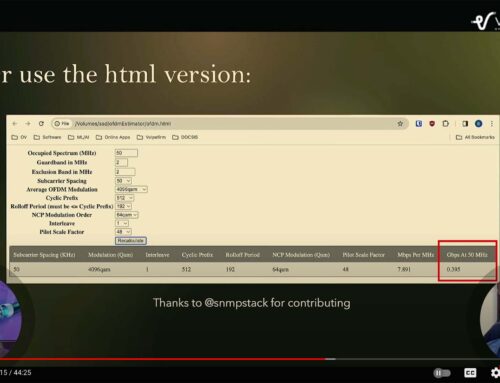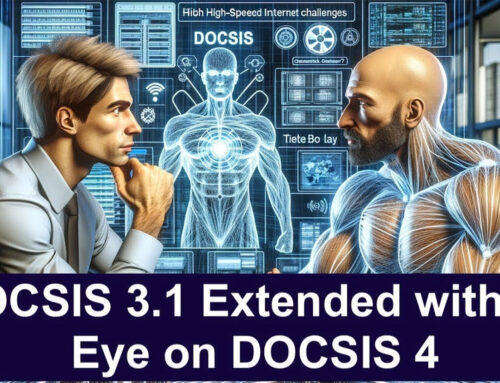DOCSIS 3.1 – BOOM – Drop the Mic. CCAP and Cable Modems the New Rock Stars in Test
We have always known that DOCSIS rocks but it is just so much cooler than we all thought. In the Winter edition of Broadband Library, I talked about how DOCSIS® 3.1 were beating expectations and performing exceptionally well in production environments. In this article, I want to focus on how the DOCSIS 3.1 specification outlines the test side, which enables operators to maintain deployed systems. Yes, you read that right, the test side. Next you might think I’ll write that DOCSIS 3.1 has baked in magic and a unicorn. Well not quite, but the built-in tests will do wonders. CCAP
When the DOCSIS 3.1 specification was under development, many people worked diligently to ensure it was the specification with the most built-in testing capabilities ever designed in the cable industry. This has come at a time in our industry when customer quality of experience is incredibly important because competition has never been greater. AT&T, Google Fiber and Verizon are actively outspending traditional cable. In the period from 2014 cable invested ~ $6 billion in capital, while competitive fiber providers invested ~ $9 billion [1].
Now that I have been working hands-on with DOCSIS 3.1 cable modem termination systems (CMTSs) and cable modems I am very happy to say that what was written in the specification is quite amazing in practical application, although there are some disappointments which I will cover later in the article. The excitement was not false as we can get an amazing wealth of data out of DOCSIS 3.1 enabled CMTS and converged cable access platform (CCAP) devices and cable modems.
Tremendous Insight in the OFDM Haystack
For most of us who have spent any time in the field troubleshooting RF problems, modulation error ratio (MER) is a metric to quickly asses the quality of a single carrier quadrature amplitude modulation (SC-QAM) channel that is 6 MHz wide (8 MHz in other parts of the world). However, a lot of impairments can occur under that 6 MHz wide channel, which means MER is often a rough estimate, leaving many impairments invisible to us.
DOCSIS 3.1 is a different animal. It is made up of subcarriers, with each subcarrier being either 25 kHz or 50 kHz wide. This means instead of getting an MER value for a 6 MHz span we can get MER values for individual subcarriers (each subcarrier is a narrow bandwidth QAM signal). Our ability to view the location of RF impairments in the downstream spectrum is now in the resolution of tens of kHz rather than multiple MHz. This is quite important because we are often looking for ingress (or egress) at high frequencies from sources such as such as long term evolution (LTE) where the bandwidth could be as narrow as 1.4 MHz [2].
The DOCSIS 3.1 specification offers several presentation methods for viewing downstream subcarrier MER. For example, we can query the mean MER across all subcarriers. This is a computed value provided by the modem. Along with the mean you can also get the standard deviation, which will enable you to quickly determine how bad the channel is without having to wade through a lot of data.
When you do notice that a DOCSIS 3.1 orthogonal frequency division multiplexing (OFDM) channel or cable modem is having impairments, DOCSIS 3.1 provides the capabilities to quickly retrieve all subcarrier MER values directly from the cable modem. This lets you find an impairment anywhere in the OFDM haystack and is a powerful feature of DOCSIS 3.1. Figure 1 shows 3,764 subcarrier MER values across a 192 MHz OFDM spectrum.

Figure 1: DOCSIS 3.1 Downstream RxMER Per Subcarrier
Looking at Figure 1 we see that most of the OFDM signal has greater than 40 dB MER. This means most of the subcarriers will support 4096-QAM. However, we quickly recognize there are some problem areas just before 900 MHz and again around 910 MHz. Time to act and DOCSIS 3.1 has more tools to help, but that is for a later article.
The data pulled from the cable modem to generate the chart in Figure 1 is roughly 4 kB! That is a lot of data using conventional SNMP. But DOCSIS 3.1 streamlines the process. Using SNMP, the cable modem is configured to send the MER per subcarrier and then, as if by magic, it uploads the 4 kB file using trivial file transfer protocol (TFTP). This is extremely efficient for the cable modem and minimizes network congestion because unnecessary back and forth SNMP we’ve relied on in the past is eliminated. This is awesome.
Additional Built-in DOCSIS 3.1 Tests Not Yet Implemented, Why?
I just demonstrated the power of just one DOCSIS 3.1 test. I would have loved to do more. Here in lies my disappointment. The DOCSIS 3.1 spec calls for so much more not yet implemented. MER per subcarrier is just the tip of the iceberg. The DOCSIS 3.1 specification has many similar tests to provide:
- Downstream symbol capture, which is just in-channel sweep for OFDM
- Constellation display from the cable modem for all modulations
- Noise power ratio (NPR) tests, which enable us to see ingress noise under the OFDM channel
- Standardized forward error correction (FEC) collection and reporting by the cable
- And more – all supporting the TFTP upload concept for efficiency
Each one of these built-in test features is sure to help operators ensure high quality, reliable data services. We will have a toolbox that enables us to detect, identify and resolve impairments in DOCSIS networks with unprecedented efficiency.
These tests will further help cable operators compete and retain subscribers. Quality of service (QoS) is key to this end.
Exciting News: Upstream Spectrum Analysis
After much anticipation and hard work in the InGeNeOs working group at CableLabs, the CCAP PNM Upstream Triggered Spectrum Capture engineering change notice (ECN) has officially been published as of January 11, 2017. The updated management information base (MIB) list was made available in September 2016 and the DOCSIS 3.1 CCAP operations support system interface (OSSI) specification can be downloaded at https://apps.cablelabs.com/specification/ccap-operations-support-system-interface-specification
Why is this important? As an industry we have created a standard for upstream spectrum analysis using the CMTS (CCAP) or remote PHY. There are two aspects of this standardization that are critical. First, every CCAP vendor will now be able to provide a common interface through which cable operators can identify the presence of upstream ingress. Of importance, this is triggered upstream spectrum analyzer functionality, which means the CCAP can be set to trigger on impulse or transient-based events. These are often the most difficult to identify, but will become more easy to detect once vendors implement the new MIBs.
Second, the new ECN enables upstream spectrum analysis in remotely deployed return CCAP architectures (remote PHY) or even CCAPs deployed in fiber nodes. In this architecture, it is very difficult if not impossible to deploy hardware return monitoring systems. Having a standardized upstream triggered spectrum analysis MIB allows cable operators to monitor return path impairments in all remote PHY nodes.
What’s Next
There is no question that the DOCSIS 3.1 testing outlined in this article will enable cable operators to have unprecedented visibility into plant impairments. As an industry, we must recognize that DOCSIS equipment must not only transport Internet protocol (IP) data, but also can detect RF impairments.
Arguments can be made that the primary purpose of the CCAP and cable modems are to transport data from point A to point B. However, the counter argument is when impairments become so severe that a subscriber’s service is impacted, it is incumbent on the hardware to actively identify the source of the impairments otherwise the hardware may as well not exist. Additionally, with competition nipping at our cable heals we need all the advantages we can get. Quality of service to maintain our subscribers is key to fighting the competition. The days of CCAP and cable modems only getting data from point A to point B have passed. This is the premise behind the substantial effort in the test functionality in the DOCSIS 3.1 specification. Data integrity is only as good as our ability to find and resolve RF impairments quickly and precisely.
With that I look forward to being able to test CCAP and cable modems to the DOCSIS 3.1 test specification once vendors make them available. Exciting times, who knows maybe I’ll find the unicorn too.
[1] https://www.ustelecom.org/blog/game-changing-cable-competition
[2] https://en.wikipedia.org/wiki/LTE_frequency_bands
By Brady Volpe
Previous events can be seen under the blog.
- If you are watching this on youtube please hit the subscribe button!
- Let us know what you think and remember to share!
- You can find slides at the bottom of the page and some on slideshare.
- Find out about events or articles by following us on Twitter, LinkedIn or Facebook too.
- We have stuff. Interested in buying some clothes with cable stuff. Click here
Also available on iTunes, Google Podcasts, Spotify, vurbl see podcasts “get your tech on”.





Leave a Reply